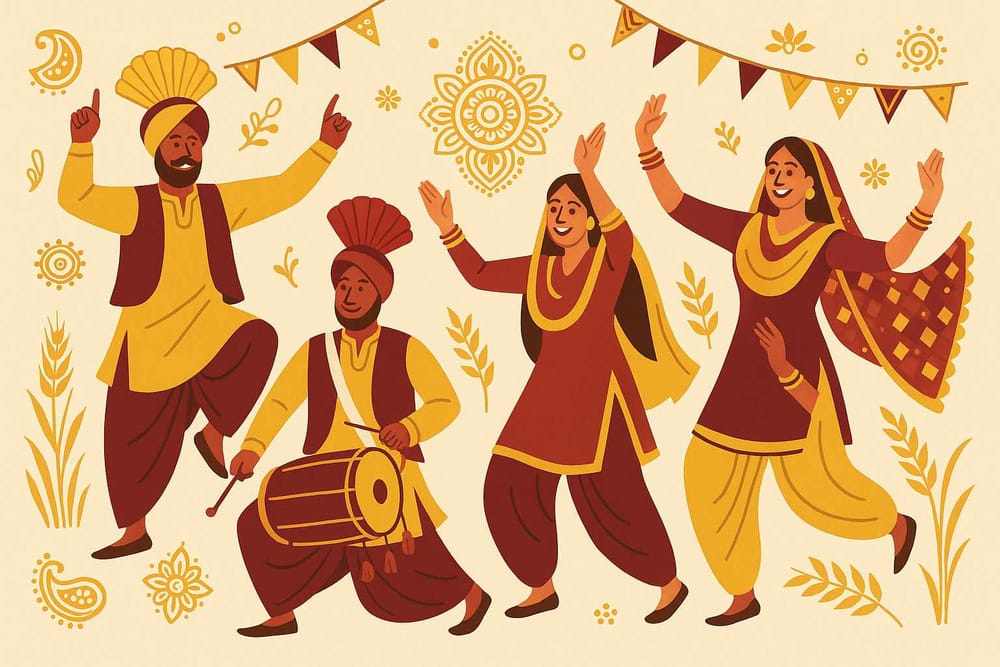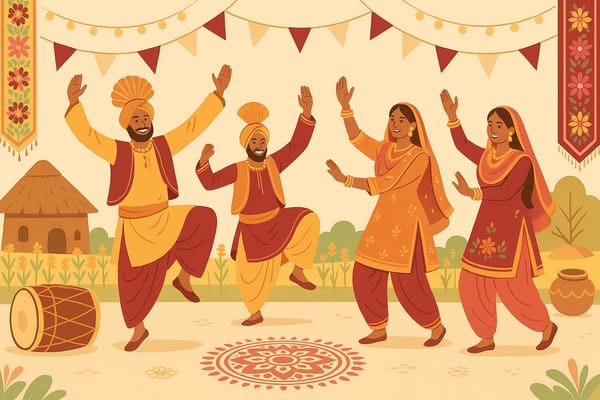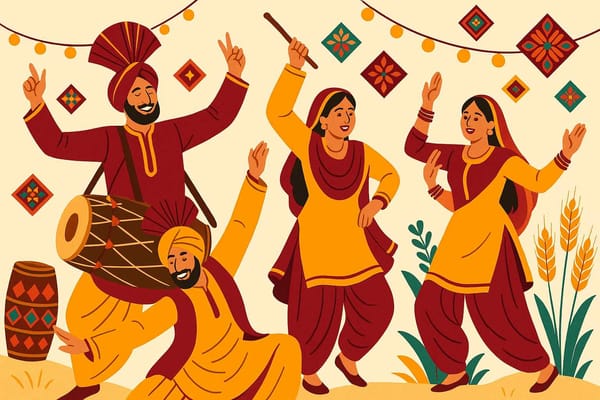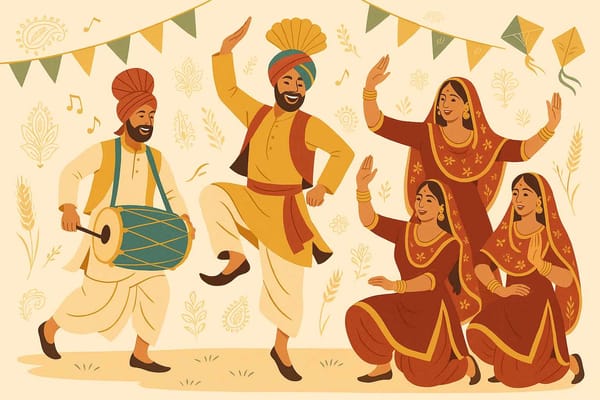
Folk Dances of Punjab: Weave the Cultural Tapestry
Have you ever felt a beat so powerful it seems to echo right in your soul? That’s the magic of Punjab for you. It’s a land where the earth itself seems to dance, where the joy of a good harvest, the celebration of a wedding, or simply the spirit of being together bursts forth in vibrant, energetic movements. The folk dances of Punjab are not just performances; they are the very heartbeat of its people, a living, breathing story told through rhythm, colour, and pure, unadulterated joy.
These dances are a beautiful reflection of life in the villages—tied to the changing seasons, the hard work in the fields, and the moments of shared laughter. They are a thread that connects generations, a legacy of strength, resilience, and an undying love for life. Let’s take a walk through the vibrant fields of Punjabi culture and feel the rhythm of its most beloved folk dances.
More Than Just Steps: The Soulful Significance of Punjabi Dance
In Punjab, dance is a form of prayer, a way of giving thanks, and a celebration of community. When the festival of Baisakhi arrives, marking the harvest season, the entire region comes alive with the beats of the dhol. This isn't just about entertainment; it's a deeply spiritual expression of gratitude for the bounty of the earth. These traditions are a cornerstone of India's vibrant regional and spiritual roots, strengthening the bonds that tie a community together.
Every dance tells a story. Through playful verses called boliyan, dancers share tales of love, bravery, and the simple joys and sorrows of daily life. The music is the lifeblood of these performances. Instruments like the mighty dhol, the playful tumbi, the rhythmic chimta, and the soulful algoza (a double flute) don’t just create a melody; they create an atmosphere that is absolutely infectious.
A Kaleidoscope of Movement: Punjab's Major Folk Dances
Punjab's treasure trove of folk dances is rich and diverse, with each form having its own unique flavour and spirit.
Bhangra: The Roar of Joy
You can’t talk about Punjabi dance without starting with Bhangra! Originally a dance to celebrate the harvest, Bhangra has become a global symbol of pure energy and celebration. It’s a powerful, high-energy dance performed by men, characterized by athletic leaps, kicks, and exuberant shoulder movements, all perfectly synchronized to the thunderous beat of the dhol. Bhangra is the very definition of Punjabi zest for life, and its infectious energy can make anyone want to jump up and join in.
Giddha: The Dance of Feminine Grace and Wit
If Bhangra is the roar, Giddha is the beautiful, lyrical echo. Performed by women, Giddha is a display of graceful movements, synchronized clapping, and immense charm. What truly makes Giddha special are the boliyan sung by the dancers. These folk couplets are often witty, and sometimes a bit cheeky, telling stories about everything from domestic life to social commentary. Giddha is a celebration of sisterhood, a space where women share their stories, laughter, and emotions with grace and style.
Jhumar: The Dance of Gentle Happiness
Originating from the Sandalbar region, Jhumar is a much slower and more rhythmic dance. It’s often called the "dance of ecstasy" but in a more gentle, graceful way. Performed in a circle, dancers move with a beautiful, swaying gait, almost like the gentle sway of trees in the wind. Jhumar reflects a more serene form of happiness and is a truly mesmerizing spectacle of coordinated, flowing movements.
Other Sparkling Gems of Punjabi Folk Dance
- Luddi: A dance that radiates the feeling of victory! Performed by men, Luddi is marked by energetic, almost snake-like movements of the head and shoulders. It’s often performed to celebrate a success, whether in a competition or in life, and its dramatic flair is captivating.
- Sammi: A traditional dance performed by women, Sammi tells a tale of longing for a loved one. With its synchronized steps and vibrant, colourful costumes, it’s a dance that showcases the resilience and quiet strength of women, often performed around a fire during festivals.
- Kikli: Full of pure, uninhibited fun, Kikli is a playful dance usually performed by young girls. Dancers form pairs, cross their arms, hold hands, and spin around in circles, laughing and singing. It’s a beautiful symbol of youthful joy and friendship.
Dressed in Tradition: The Attire and Music
The visual appeal of these dances is magnified by the stunning traditional attire. Women wear brightly coloured Salwar Kameez or Ghagra, often adorned with intricate embroidery. The star of the show is the Phulkari dupatta, a hand-embroidered veil bursting with floral patterns that flow beautifully with every movement. Accessories like the paranda (a colourful hair tassel) add to the charm.
Men look equally regal in their colourful turbans, which are a symbol of pride and honour. They wear loose-fitting kurtas and a traditional lungi or dhoti, designed for comfort and ease of movement during the energetic dances. Together, the vibrant costumes and the soul-stirring music create an unforgettable sensory experience, which is a key element of how folk music and dance define our culture.
Exploring these beautiful traditions can often deepen our spiritual and cultural understanding. It reminds us of the richness embedded in our everyday rituals and celebrations. If you feel drawn to explore more about our timeless devotional and cultural heritage, we invite you to visit Bhaktilipi.in. It’s a space we've lovingly created to share stories and knowledge that connect us to our roots.
Keeping the Flame Alive: Folk Dances in the Modern World
In a world that’s changing so fast, how do these traditions survive? The beauty of Punjab's folk dances is that they have not only survived but have thrived by adapting. Bhangra has found its way into gyms as a fitness routine and into Bollywood films, making it a global phenomenon. Many people often ask if these dances are just for festivals. While they are a huge part of celebrations like Lohri and weddings, their influence is now seen everywhere.
At the same time, there is a strong movement to preserve their authenticity. Cultural organizations and schools across Punjab and in diaspora communities are making sure that the younger generation, including children, learns these dances in their true form. This ensures that while the art form evolves, its soul remains untouched. These dances are a powerful way for Punjabis living across the globe to stay connected to their heritage and pass it on with pride.
A Celebration for a Lifetime
The folk dances of Punjab are far more than just art. They are a powerful expression of a culture that is bold, beautiful, and full of heart. From the powerful beats of Bhangra to the graceful twirls of Giddha, each dance tells a story of unity, joy, and an unbreakable connection to the land.
By celebrating these dances, we are not just preserving a tradition; we are keeping a vibrant legacy alive. Let’s cherish these rhythms and stories, for they are the threads that weave the magnificent cultural tapestry of Punjab, inspiring us for generations to come.
A passionate group of people dedicated to preserving India's knowledge of Dharma, Karma, and Bhakti for ourselves and the world 🙏.
Comments
Related in

Folk Dances of Punjab - Celebrate Rich Culture
The moment you hear the deep, resonant beat of a dhol, something inside you stirs. It’s a call to joy, a rhythm that travels from your ears to your feet, making you want to move. This is the magic of Punjab, a land where every celebration, every season, and

Vibrant Folk Dances of Punjab: A 2025 Cultural Journey
The very soul of Punjab beats to the rhythm of the dhol. It’s a sound that echoes through its lush green fields, a sound that calls people to gather, to celebrate, to feel alive. This isn't just music; it's the living, breathing essence of Punjabi

The Vibrant Rhythms: Folk Dances Define Punjab
Can you hear it? That powerful, soul-stirring beat of the dhol that makes your feet want to tap and your heart want to soar. That, my friend, is the sound of Punjab. It’s a land where joy isn't just felt; it's danced. The folk dances
